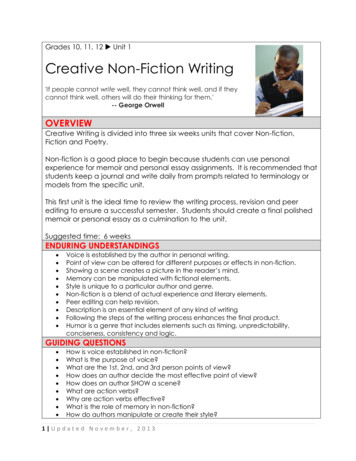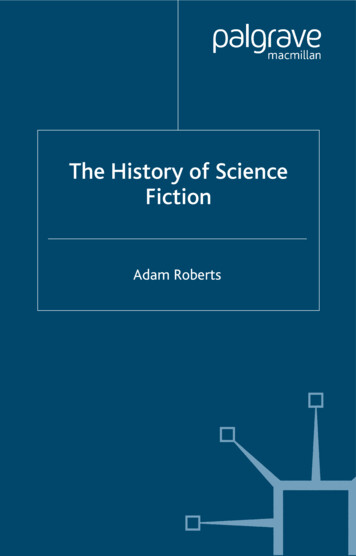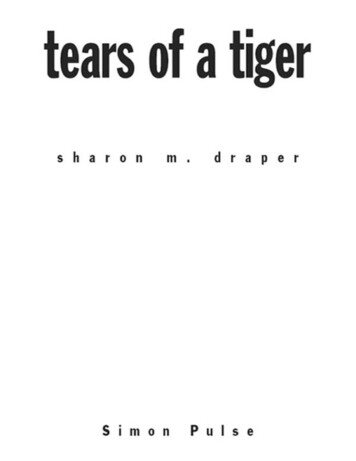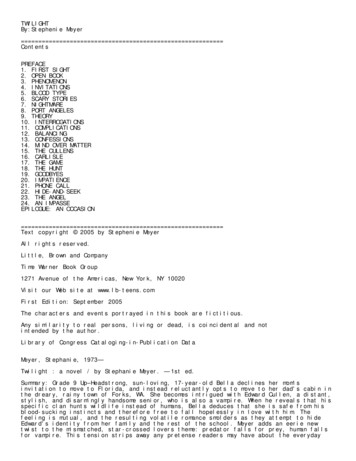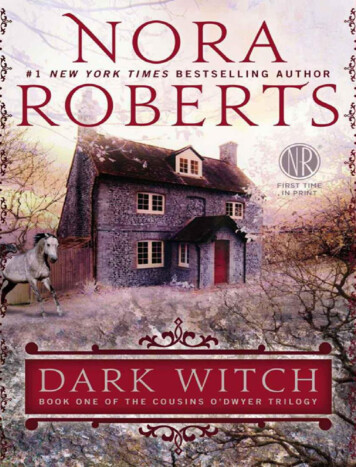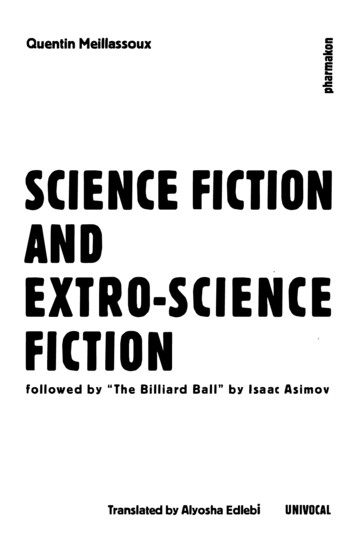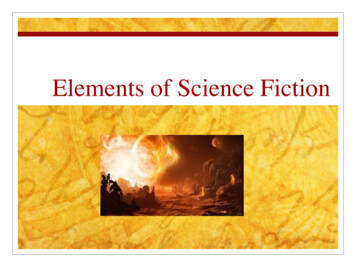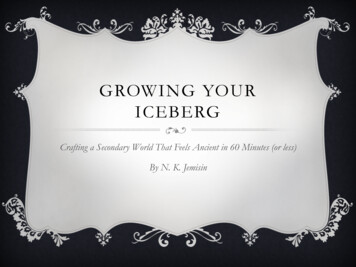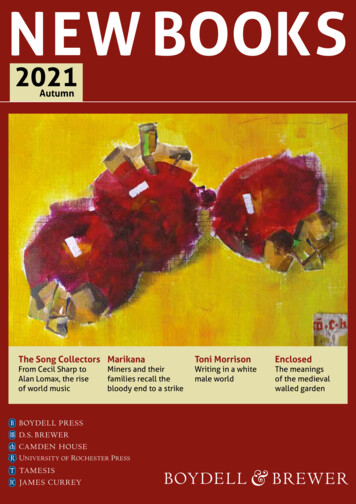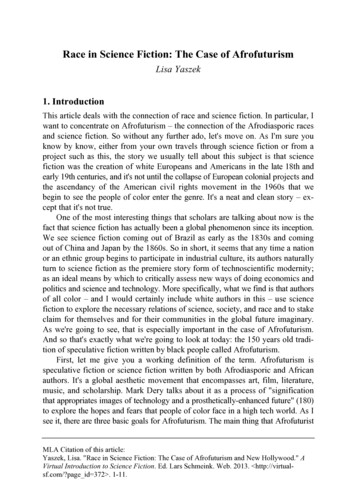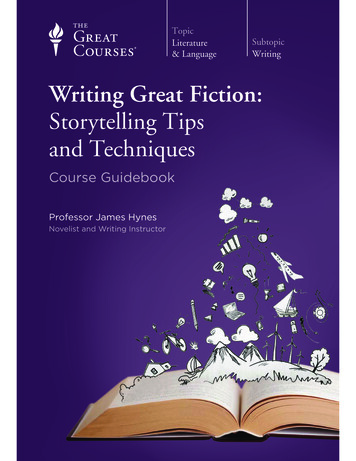
Transcription
TopicLiterature& LanguageSubtopicWritingWriting Great Fiction:Storytelling Tipsand TechniquesCourse GuidebookProfessor James HynesNovelist and Writing Instructor
PUBLISHED BY:THE GREAT COURSESCorporate Headquarters4840 Westfields Boulevard, Suite 500Chantilly, Virginia 20151-2299Phone: 1-800-832-2412Fax: 703-378-3819www.thegreatcourses.comCopyright The Teaching Company, 2014Printed in the United States of AmericaThis book is in copyright. All rights reserved.Without limiting the rights under copyright reserved above,no part of this publication may be reproduced, stored inor introduced into a retrieval system, or transmitted,in any form, or by any means(electronic, mechanical, photocopying, recording, or otherwise),without the prior written permission ofThe Teaching Company.
James Hynes, M.F.A.Novelist and Writing InstructorProfessor James Hynes is a working novelistwho has taught creative writing as avisiting professor at the University of IowaWriters’ Workshop, the University of Michigan,The University of Texas, Miami University, andGrinnell College. He earned a Bachelor of Artsdegree in Philosophy from the University ofMichigan in 1977 and a Master of Fine Arts degree from the Iowa Writers’Workshop in 1989.Professor Hynes is the author of four novels: Next, which received the 2011Believer Book Award from Believer magazine; .LQJV RI ,Q¿QLWH 6SDFH,a :DVKLQJWRQ 3RVW best book for 2004; 7KH /HFWXUHU¶V 7DOH; and 7KH :LOG &RORQLDO %R\, which received the Adult Literature Award from the Friendsof American Writers and was a New York Times Notable Book for 1990. Hisnovella collection 3XEOLVK DQG 3HULVK 7KUHH 7DOHV RI 7HQXUH DQG 7HUURU wasa 3XEOLVKHUV :HHNO\ Best Book of 1997 and appeared on several critics’ bestof-the-year lists.Professor Hynes has received numerous literary grants and teachingfellowships. He received a James Michener Fellowship from the Universityof Iowa (1989–1990), and he was a member of the Michigan Society ofFellows at the University of Michigan (1991–1994). He received a TeachingWriting Fellowship from the Iowa Writers’ Workshop at the University ofIowa (1988–1999) and a Michigan Council for the Arts writer’s grant (1984).As an undergraduate, he received the Hopwood Short Fiction Award fromthe University of Michigan (1976).Professor Hynes is also a media and literary critic. He is a former televisioncritic for 0RWKHU -RQHV, 7KH 0LFKLJDQ 9RLFH, and ,Q 7KHVH 7LPHV. His bookreviews and literary essays have appeared in 7KH New York Times, 7KH:DVKLQJWRQ 3RVW, Boston Review, 6DORQ, and other publications.i
Professor Hynes lives in Austin, Texas, the main setting of his novel Next,DQG LV FXUUHQWO\ ZRUNLQJ RQ D QHZ QRYHO Ŷii
Table of ContentsINTRODUCTIONProfessor Biography .iCourse Scope .1LECTURE GUIDESLECTURE 1Starting the Writing Process .4LECTURE 2Building Fictional Worlds through Evocation .10LECTURE 3How Characters Are Different from People .17LECTURE 4Fictional Characters, Imagined and Observed .24LECTURE 5Call Me Ishmael—Introducing a Character.31LECTURE 6Characters—Round and Flat, Major and Minor .38LECTURE 7The Mechanics of Writing Dialogue .45LECTURE 8Integrating Dialogue into a Narrative .52LECTURE 9And Then—Turning a Story into a Plot .59LECTURE 10Plotting with the Freytag Pyramid .65iii
Table of ContentsLECTURE 11Adding Complexity to Plots.72LECTURE 12Structuring a Narrative without a Plot .78LECTURE 13In the Beginning—How to Start a Plot .84LECTURE 14Happily Ever After—How to End a Plot .90LECTURE 15Seeing through Other Eyes—Point of View.97LECTURE 16I, Me, Mine—First-Person Point of View.104LECTURE 17He, She, It—Third-Person Point of View . 111LECTURE 18Evoking Setting and Place in Fiction . 118LECTURE 19Pacing in Scenes and Narratives .125LECTURE 20Building Scenes .132LECTURE 21Should I Write in Drafts?.139LECTURE 22Revision without Tears.145LECTURE 23Approaches to Researching Fiction.152iv
Table of ContentsLECTURE 24Making a Life as a Fiction Writer .159SUPPLEMENTAL MATERIALAppendix: Punctuating Dialogue .165Bibliography .169v
vi
Writing Great Fiction:Storytelling Tips and TechniquesScope:We all think we have a novel in us, and in this course of 24 lectures,a professional novelist will guide you through a survey of themost important concepts and techniques behind the creation ofFRQWHPSRUDU\ SURVH ¿FWLRQ XVLQJ H[DPSOHV IURP D ZLGH UDQJH RI FODVVLF novels and stories, as well as some demonstrations of his own process. Bytaking you step by step through such topics as creating characters, composingdialogue, crafting plots, and using different points of view, this course willhelp you get that book out of your head and heart and into the hands of readers.Lecture 1 considers how to prepare yourself, both logistically andHPRWLRQDOO\ IRU EHJLQQLQJ WR ZULWH D SLHFH RI ¿FWLRQ DQG /HFWXUH H[SORUHV WKH FRQFHSW RI HYRFDWLRQ RU WKH DUW RI PDNLQJ ¿FWLRQDO FKDUDFWHUV LQ D ¿FWLRQDO ZRUOG FRPH DOLYH ZKLFK LV IXQGDPHQWDO WR PRVW ¿FWLRQ 7KH QH[W IRXU OHFWXUHV SURYLGH DQ LQWURGXFWLRQ WR WKH FUHDWLRQ RI ¿FWLRQDO FKDUDFWHUV ,Q /HFWXUH ZH H[SORUH WKH GLIIHUHQFHV EHWZHHQ ¿FWLRQDO characters and real people and consider how a “person” who is only a fewthousand words on a page can come to life in the mind of the reader. Lecture4 shows how you can create credible and interesting characters by combiningyour imagination with observations of real people. Lecture 5 looks at severalZD\V RI LQWURGXFLQJ D FKDUDFWHU LQWR D QDUUDWLYH IRU WKH ¿UVW WLPH DQG /HFWXUH H[DPLQHV GLIIHUHQW W\SHV RI FKDUDFWHUV VXFK DV URXQG DQG ÀDW FKDUDFWHUV and major and minor characters, and explores how they work together in astory or novel.The next two lectures are about writing dialogue. Lecture 7 explains themechanics and grammar of dialogue, including tips on when and when notto use dialogue tags and adverbs. Lecture 8 is about using dialogue to evokecharacter and tell a story and about integrating dialogue seamlessly into therest of the narrative.1
SasaJo/iStock/Thinkstock.Next comes the longest block of lectures in the course, six lectures aboutplot. Lecture 9 introduces the subject by discussing the difference betweena story and a plot and by showing three ways to structure a traditional plot.Lecture 10 demonstrates how traditional plots can usually be diagrammedwith the well-known Freytag pyramid, while Lecture 11 suggests waysyou can rearrange or adaptthe individual pieces ofa traditional chronologyto make your plot morecomplex and intriguing.Lecture 12 covers how tostructure a narrative whenyou’re not interested inusing a traditional plot;Lecture13introducestechniques for getting aplot started; and Lecture 14explores ways to bring a plotto a satisfying conclusion.ScopeThe next three lecturesdiscuss the concept of pointRI YLHZ LQ ¿FWLRQ /HFWXUH 15 surveys the range ofpoints of view, from theJRGOLNH RPQLVFLHQW WKLUG SHUVRQ WR WKH LQWLPDF\ RI WKH ¿UVW SHUVRQ /HFWXUH ORRNV DW WKH YDULRXV ZD\V \RX FDQ XVH WKH ¿UVW SHUVRQ SRLQW RI YLHZ DQG Lecture 17 runs through the many varieties of the third person.The remaining seven lectures look at a variety of individual topics ofLPSRUWDQFH WR ¿FWLRQ ZULWHUV /HFWXUH GLVFXVVHV WKH YDULRXV ZD\V VHWWLQJ DQG SODFH FDQ EH XVHG LQ ¿FWLRQ ZKLOH /HFWXUH H[SORUHV SDFLQJ DQG WKH need to pace different types of narratives in different ways. Lecture 20considers how to craft an individual scene, which is one of the basic buildingEORFNV RI ¿FWLRQ DQG /HFWXUH ORRNV DW WKH DGYDQWDJHV DQG GLVDGYDQWDJHV of composing manuscripts in complete drafts. In Lecture 22, we’ll takea look at the essential process of revision and rewriting, while Lecture2
FRQVLGHUV WZR DSSURDFKHV WR GRLQJ UHVHDUFK IRU D ZRUN RI ¿FWLRQ 7KH ¿QDO OHFWXUH WRXFKHV RQ WKH FKDQJLQJ QDWXUH RI WKH SXEOLVKLQJ EXVLQHVV DQG offers personal insights into the challenges and joys of making a life as a¿FWLRQ ZULWHU Ŷ3
Starting the Writing ProcessLecture 1WKHWKHU \RX¶UH D EHJLQQHU VWDUWLQJ \RXU ¿UVW VWRU\ HYHU RU D professional with many publications behind you, few thingsmake a writer more anxious than facing a blank page. Oneapproach to overcoming this obstacle is to think about what the opening ofa story is supposed to do: draw readers in and capture their curiosity. Thebeginning should also suggest something important about the story—themain characters, the tone, or the setting. But even if you know the story youZDQW WR WHOO KRZ GR \RX GHFLGH ZKDW WKH ¿UVW SDUDJUDSK RU VHQWHQFH VKRXOG be? In this lecture, we’ll look at some ways to make the beginning seemless foreboding.Lecture 1: Starting the Writing ProcessThree Questionsz One way to sneak up on the start of your story is to break the question“How shall I begin?” into three separate questions: the artistic question,the logistical question, and the psychological question.z Simply put, the artistic question is: What is this story about? What’sthe idea you want to explore? You may have an entire plot worked outin your head already, or you may have only a character or a situation inmind. Whatever it is, something has motivated you to write.z The logistical question relates to the technical aspects of starting a story,the basic decisions you have to make at the start even if you don’t knoweverything about your story. This is actually a number of questionscombined, such as: Who’s telling the story? What verb tense will youuse? What voice is the story in? These early choices can be dauntingbecause every decision you make will have consequences later on,many of which you can’t foresee.z Finally, the psychological question relates to how you gear up—emotionally—to begin. Even published writers become anxious aboutstarting something new. Trying to leap that psychological hurdle4
LQYROYHV EHLQJ DEOH WR DQVZHU WKH ¿UVW WZR TXHVWLRQV DW OHDVW LQ SDUW That, in turn, ratchets up the anxiety, because there’s so much you couldworry about in advance that it’s a wonder anyone ever starts at all.The Five Wsz QRWKHU ZD\ WR DSSURDFK VWDUWLQJ D ZRUN RI ¿FWLRQ LV E\ XVLQJ WKH ROG IDVKLRQHG ¿YH :V RI MRXUQDOLVP ZKR ZKDW ZKHUH ZKHQ DQG ZK\ Assuming you have a rough idea of what you want to write about, try togive a brief answer to each of these questions pertaining to the story youwant to tell.z 7KH ¿UVW TXHVWLRQ WR DGGUHVV LV :KR DUH \RXU FKDUDFWHUV DQG KRZ DUH they related to each other? The who question also encompasses thechoice of point of view, that is: Who is your protagonist, and who isyour narrator? Sometimes these two are the same person, but that’s notalways the case. Often, the story is told by a third-person narrator, whocan vary from the godlike, seeing into each character’s thoughts, to onewho is more like a surveillance camera, relating what the characters dowithout revealing their inner lives.z The answer to the who question determines, in large part, howyou answer the next question: What happens in the story? Anotherinterpretation of this question is: What is your story about? Do you havesome larger theme you want to get across, or are you just telling a goodtale? Even if it’s the latter, you still have to think about another versionof the what question: What effect do you want the story to have onthe reader?z 7KH ZKHUH TXHVWLRQ VHHPV UHODWLYHO\ VLPSOH DW ¿UVW JODQFH :KHUH is the story set? But this question leads to a more complex one: Howimportant is the setting of the story to the story itself? In answeringWKH ZKHUH TXHVWLRQ \RX GHFLGH ZKHWKHU \RXU VWRU\ LV WLHG WR D VSHFL¿F geographical and historical context and whether it is, in part, about thatplace and time or whether it is more archetypal and timeless.z The question of when the story takes place is also more complex than itVHHPV DW ¿UVW ,W FDQ LGHQWLI\ WKH KLVWRULFDO WLPH RI WKH VWRU\ RU WKH WLPH 5
it takes place in the lives of the characters. It also asks: When is thestory being told in relation to when it happened? Is it being narrated inthe present tense or in the past tense by a present-day narrator? If youWHOO D VWRU\ LQ WKH SDVW WHQVH \RX JDLQ WKH EHQH¿W RI KLQGVLJKW EXW LI \RX tell it in the present tense, what you lose in hindsight you may gain inimmediacy and suspense.o Other aspects of the when question include: At what point inthe story does the plot begin, and how do you order the eventsof the plot? Do you tell the story chronologically, backward, ormoving backward and forward in time?oLecture 1: Starting the Writing Processz Answering this question is at the heart of learning how toconstruct a plot, because you come to realize that the sameseries of chronological events can be told in many differentways. By deciding what to reveal and when, you’re choosingthe most important moments in the plot.Finally, the why question asks: Why do the characters do what they do?What do the characters want, and why are they in the situation of thestory? Is it a situation of their own making, or is it a situation that hasbeen thrust upon them? Of course, asking why the characters do whatthey do is both the hardest and the most essential question you mustanswer. Indeed, for many writers, trying to answer this question is thereason they write novels or stories to begin with.A Simple Story?z To illustrate how the answers to these questions might help you getstarted, let’s take a simple story as an example. Let’s say we have amarried couple, Sarah and Brad. One Friday night, they decide to takein a baseball game, but during the middle of the game, Sarah tells Bradthat she’s unhappy in the marriage and wants a divorce.z 6On the face of it, this seems to be a simple story; we started withWZR FKDUDFWHUV DQG D VSHFL¿F VHWWLQJ DQG ZH WROG ZKDW KDSSHQHG LQ chronological order. But as soon as Sarah says that she wants a divorce,WKH VWRU\ EHFRPHV PRUH FRPSOLFDWHG WKDQ LW VHHPHG DW ¿UVW ,W WXUQV RXW
to have started before the “beginning,” and it sets up a complex dynamicbetween the two characters.z A couple of lessons can be learned from this example. One is that a storyis not mere chronology. In fact, we might say that most stores are notchronologies but rely on backstories. In his famous series of lecturesDERXW ¿FWLRQ ZULWLQJ VSHFWV RI WKH 1RYHO, the British novelist E. M.Forster made a distinction between story and plot. Story, accordingto Forster, is the chronological listing of events; plot is the story pluscausality and motivation.z Another way of looking at this idea is to consider that all stories begin inPHGLDV UHV, “in the middle of things.” Even stories that seem to begin atthe very beginning, such as the opening of the book of Genesis, actuallybegin in the middle. Although it may seem as if we can’t get much closerto the beginning than “in the beginning,” even this opening presumes apreviously existing character—God.z 7KLV OHDGV WR D ODUJHU SKLORVRSKLFDO SRLQW DERXW ¿FWLRQ /LWHUDWXUH is the creation of order out chaos and the creation of meaning out ofmeaninglessness. Stories may feel natural, but they don’t occur innature. As writers, we imagine a series of events or we borrow themfrom life, we order them in a certain way, we choose to highlight somefacts and ignore others, and we bring these events and characters to aconclusion or a resolution.z The fact that even a simple-seeming story can suddenly turn complicatedEULQJV XV EDFN WR WKH GLI¿FXOW\ RI GHFLGLQJ ZKHUH WR EHJLQ :H NQRZ WKH basic facts about Sarah and Brad, but to explore this situation, we muststart making choices—about what’s important to tell, what’s not, whosepoint of view to tell it from, and when in the story to begin.z (YHQ LI \RX¶YH GHFLGHG RQ WKH DQVZHUV WR WKH ¿YH :V \RX VWLOO KDYH WR WKLQN RI WKH ¿UVW ZRUGV RI WKH VWRU\ 'R \RX RSHQ ZLWK D GHVFULSWLRQ WKDW sets the scene, an exchange of dialogue, an interior monologue, someaction, or a combination of these? One possible solution is to outlinethe story in advance, but many writers prefer to improvise as they work.7
This approach allows you to discover the story in much the same waythat a reader does.Lecture 1: Starting the Writing Processz First of all, writing a storyis not necessarily linear;you don’t have to write itthe way the reader will readit. Writing can be more likeputting a puzzle together:You can start anywhere inthe story; then, when thelarger picture gets clearer,you can craft a beginning. Stockbyte/Thinkstock.Psychological Question Revisitedz It’s clear that starting a story involves making a number of choices,and that, in turn, can ratchet up a writer’s anxiety. Let’s return, then, tothe psychological question mentioned earlier: How do you gear up—emotionally—to begin? One way to sneak up on this question is toremind yourself of what youdon’t need to do or know tostart a story.A whole novel might be developed byDQVZHULQJ WKH ¿YH :V DERXW D FRXSOH DW a baseball game, working backward andforward in the characters’ lives.z You also don’t have toknow how the story ends.Sometimes knowing the ending is a good thing because it gives you apoint to aim at, but sometimes not knowing can allow you to discoverwhere the story itself wants to go along the way.z Further, you don’t have to have an outline, and even if you do, you don’thave to stick to it. Be prepared for happy accidents.z Your story doesn’t even have to be good to begin with. As a writer, youhave the luxury of being able to do as many drafts of a story as it takesto get it right, or you can revise as you go along. Don’t be afraid toVWDUW RYHU RU JR EDFN DQG ¿[ VRPHWKLQJ QR PDWWHU ZKHUH \RX DUH LQ the process.8
z Finally, keep in mind that creative writing isn’t a science. The only rulein this endeavor is: Whatever works. Throughout these lectures, we’lllook at many choices for presenting stories; the best way you can usethe lectures is to adapt the possibilities in these choices to your ownwork, taking whatever is useful and ignoring the rest.Suggested ReadingForster, VSHFWV RI WKH 1RYHO.Writing Exercise1. Without thinking too hard about it, try to recall a vivid image youmay have seen recently, in real life or on television, and see if you canimagine a story to explain it. You can start with the Faulkner technique:Simply describe the image, such as a mother yelling at her child in thesupermarket, then branch off from there, explaining why the mother is soH[DVSHUDWHG RU ZK\ WKH FKLOG LV EHLQJ VR GLI¿FXOW 7KHQ WU\ )LW]JHUDOG¶V technique with the same image: Outline the life of the mother so far—her girlhood, her courtship, the birth of her child—and work up to themoment in the supermarket. See which approach works best for you.9
Building Fictional Worlds through EvocationLecture 2OLecture 2: Building Fictional Worlds through Evocationne of the most venerable tropes in the teaching of creative writingis this: Show, don’t tell. But what exactly does this dictum mean?When teachers of creative writing invoke it, they often mean that aVFHQH RU VWRU\ ZDV XQGHU GUDPDWL]HG RU WKDW WKH ZULWLQJ WUDI¿FNHG LQ YDJXH generalities. For example, a writer might tell us something that is generallyWUXH DERXW D FKDUDFWHU ZLWKRXW ¿[LQJ WKDW WUDLW RU DFWLRQ LQ D VSHFL¿F PRPHQW or situation. In this lecture, we’ll see how showing rather than telling canmake your writing more immediate, vivid, detailed, and visceral. We’ll seehow it invites readers to identify with your characters and participate in thestory, if only in their imaginations.Telling versus Showingz Let’s consider two versions of a scene, one that gets the facts acrossand one that puts the reader in the scene with the characters. Here’s the¿UVW YHUVLRQI was driving home from work this afternoon when some jerkcame out of a side street and cut right in front of me. I wasangry about something my boss had said that afternoon, soinstead of just letting it go, I sounded my horn and tailgatedthe guy for half a mile. He pulled over, and we nearly got intoD ¿JKW z 1RZ OHW¶V ORRN DW DQ H[FHUSW IURP ZKDW D ¿FWLRQ ZULWHU PLJKW GR ZLWK this same scene:Naturally, as I was just about to cross the river, a guy in a JeepCherokee with enormous tires shot out right in front of me andcut me off. Worse yet, he was a young guy, with big rednecksideburns and a feed cap, and when I honked my horn, he gavePH WKH ¿QJHU DQG D ELJ QDVW\ JULQ :RUVW RI DOO KH KDG RXW RI 10
state plates and an NRA bumper sticker, and all of these, alongwith my rage at my boss, made me erupt.z Note that the outline of the two versions is the same, but the secondversion has much more detail. Instead of “a guy shot out in front of me,”it’s a young guy with sideburns and a baseball cap. He not only cutsthe narrator off, but he seems to enjoy it. It’s essentially the same story,EXW WKH VHFRQG YHUVLRQ LV ÀHVKHG RXW ZLWK PDQ\ PRUH GHWDLOV DERXW WKH two characters and the setting. The reader is much closer to being in themind of the narrator.z When creative writing teachers say, “Show, don’t tell,” they mean: Giveus more detail, make it dramatic, and put the reader in the scene.o :ULWLQJ ¿FWLRQ E\ VKRZLQJ UDWKHU WKDQ WHOOLQJ PHDQV E\SDVVLQJ the logical, analytical mind and going for the gut, engaging thereaders’ senses, not just their minds. More important, you’reHQJDJLQJ WKH UHDGHUV¶ LPDJLQDWLRQV DQG DOORZLQJ WKHP WR ¿OO LQ the gaps by drawing on their own experience.oWhat you’re doing, in fact, is evoking the experience for theUHDGHU 7KH LGHD RI HYRFDWLRQ LV DW WKH KHDUW RI DOO ¿FWLRQ LW¶V WKH WKLQJ WKDW DOORZV D ¿FWLRQDO VWRU\ DQG LPDJLQDU\ FKDUDFWHUV to lodge themselves ineradicably in the minds of readers.'H¿QLQJ Evocationz The variants of the word evoke come from the Latin HYRFDUH, whichmeans “to call out” in several different senses: to summon the spirits ofthe dead, to call forth a deity, or simply to summon another person. In(QJOLVK ZKHQ WDONLQJ VSHFL¿FDOO\ DERXW DUW DQG OLWHUDWXUH WKH GLFWLRQDU\ GH¿QLWLRQ RI HYRFDWLYH is “tending by artistic imaginative means toUH FUHDWH especially in such a manner as to produce a compellingimpression of reality.”z In English, evoke, HYRFDWLYH, and HYRFDWLRQ can also mean “callingout or calling forth,” “summoning a spirit by incantation,” “callingup an emotional response,” or “calling up memories, recollections,or associations.” All these meanings apply when it comes to writing11
¿FWLRQ EHFDXVH DOO WKHVH GH¿QLWLRQV KDYH LQ FRPPRQ WKH LGHD RI GUDZLQJ something out of a reader’s imagination, not just putting something into it.When you tell readers something, you appeal mainly to the rational,analytical mind, not to the senses. But when you show readerssomething, you draw out something that is already present—memoriesor imaginings—even if your readers don’t know it. In other words,when you tell readers something, you make them witnesses, but whenyou show them something, you make them participants.z Evocation is both a subtle and a powerful technique. It entails both thewriter and the reader using their imaginations.o Writers use their skill with words to call forth scenes fromtheir imaginations in enough detail that readers, without reallythinking about it, use their own imaginations and memoriesWR ¿OO LQ WKH JDSV ,Q WKH SURFHVV PHPRULHV HPRWLRQV DQG sensory impressions are evoked.Lecture 2: Building Fictional Worlds through Evocationz 12o2QH RI WKH EHQH¿WV RI HYRFDWLRQ LV WKDW HYHQ WKRXJK UHDGHUV are doing half the work, they don’t realize it, and they actuallyenjoy the experience. The feeling of being in the scene withthe characters and being engaged by the narrative is one ofWKH JUHDW SOHDVXUHV RI UHDGLQJ ¿FWLRQ SKUDVH WKDW EULOOLDQWO\ captures this effect comes from the American novelist andFUHDWLYH ZULWLQJ WHDFKHU -RKQ *DUGQHU ZKR RQFH GH¿QHG ¿FWLRQ as the creation of “a vivid and continuous dream.”oIn her book :ULWLQJ )LFWLRQ, another creative writing teacher,-DQHW %XUURZD\ VDLG WKDW UHDGLQJ ¿FWLRQ DOORZV XV WR IHHO VWURQJ emotions “without paying for them.” This is what evocation isall about. When you get the reader to laugh, you’re evokingmerriment; when you get the reader to sweat and turn on allthe lights, you’re evoking fear. You don’t just allow readers tovisualize themselves in certain situations, but you prompt themto engage with the situation emotionally in the same way theywould if they were actually experiencing it in real life.
By mid-May, the sun risesout of the morning’s hazewith authority and potency,and standing on your topstep at seven in the morningwith your dinner bucket inyour hand, you know thatthe dew will be melted offthe grass by eight and thatthe dust on the back roadsevoking memories we all havewill hang depthless and still Byof heat and dust, an author can drawLQ WKH KRW DLU IRU ¿YH PLQXWHV us out of our own lives and intoafter a car’s passage; and the life of a laborer in another timethat by one in the afternoon and place.LW ZLOO EH XS WR QLQHW\ ¿YH RQ WKH WKLUG ÀRRU RI WKH PLOO DQG WKH VZHDW ZLOO UROO RII \RXU arms like oil and stick your shirt to your back in a wideningpatch and it might as well be July. (pp. 192–193) Thinkstock Images/Stockbyte/Thinkstock.The Balance of Detail and Economyz Stephen King’s ¶6DOHP¶V /RW isone of the best horror novels everwritten. Here’s a passage from itin which King evokes the arrivalof spring in New England:z This passage is a wonderful example of how evocation works becauseit gives us a nice balance between detail and economy. As we’ve said,HYRFDWLYH ZULWLQJ SURYLGHV VLJQL¿FDQW GHWDLO EXW LW GRHVQ¶W RYHUZKHOP the reader. The point is to draw something out of your readers, whichyou can’t do if you pour too much in.z This is a tricky balance to get right, and beginning writers often haveWKH PRVW GLI¿FXOW\ ZLWK LW -XVW DV RQH FRPPRQ HUURU DPRQJ \RXQJ writers is not providing enough detail, another common error is toovercompensate by telling too much. Often, inexperienced writers will13
go on for several paragraphs about the appearance of a character or aplace when a few well-chosen sentences or words would have done justas well.z What are the right details to include? One way to answer that questionis to include too much detail in your early drafts. Write much more thanyou need, then pare it back later.o You can also ask yourself some questions about the detailsyou provide: Does this detail tell something that the readerdidn’t already know? Does it advance the story? Does it sayVRPHWKLQJ DERXW WKH FKDUDFWHU WKDW LV VSHFL¿F WR WKLV VFHQH" Lecture 2: Building Fictional Worlds through Evocationoz Another issue to consider in making a passage evocative is the languageitself. There are no rules in creative writing, but on the whole, evocationZRUNV EHVW ZKHQ \RX XVH DFWLYH VSHFL¿F YHUEV DQG DYRLG DGYHUEV XQOHVV they’re absolutely necessary.o Inexperienced writers often write such sentences as “She hurriedquickly across the room” or “He pounded the table angrily.” Inthese examples, the adverbs are unnecessary; it’s clear from theverbs that she’s moving quickly or that he is angry.o14Think about whether your details are concrete and appealdirectly to the senses. Don’t just write, “He was in love withher”; instead, write, “He felt his face get hot when she cameinto the room.”In most cases, use the strongest verbs you can think of. “It wasraining” is not as evocative as “The rain hammered the roofand spattered the windows like buckshot.” Instead of startingwith the bland pronoun it and the even blander verb ZDV, thesecond sentence makes the rain itself the subject; the strongverb KDPPHUHG evokes not only an image but a sound andUHQGHUV DQ\ DGYHUEV VXSHUÀXRXV
Telling, Not Showingz 'HVSLWH WKH LPSRUWDQFH RI HYRFDWLRQ LQ ¿FWLRQ LW¶V DOVR VRPHWLPHV acceptable—even preferable—to tell a story rather than to show it.Many of the great books of the 18th and 19th centuries used telling astheir default mode, as do many philosophical and satirical novels.z In most conventional narratives, where much of the story is shown orevoked, there are also long passages in which the writer or narratorsimply addresses the readers, telling them what they need to know. Justas a composer might vary the tempo of a piece of music to maintainWKH OLVWHQHU¶V LQWHUHVW WKH ¿FWLRQ ZULWHU VKRXOG SURYLGH YDULHW\ DPRQJ intensely evocative scenes, passages of pure exposition, and scenes thatcombine the two.z ,Q VFLHQFH ¿FWLRQ DQG IDQWDV\ IRU H[DPSOH WKHUH LV RIWHQ D SDVVDJH RU even an entir
taking you step by step through such topics as creating characters, composing dialogue, crafting plots, and using different points of view, this course will help you get that book out of your head and heart
